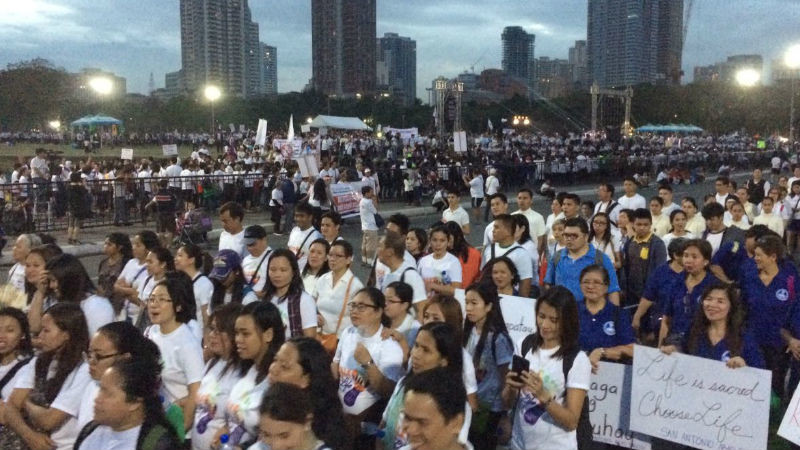
Walk for life against extra judicial killings and death penalty at Quirino Grandstand, Manila. NIÑO JESUS ORBETA / Philippine Daily Inquirer
An estimated 20,000 people thronged Luneta on Saturday morning for the “Walk of Life” organized by the Catholic Bishops’ Conference of the Philippines. The prayer rally was called by the bishops to protest the wave of extrajudicial killings that has marked the first seven months of President Duterte’s administration, as well as the looming reimposition of the death penalty by Congress.
Malacañang had earlier pooh-poohed the event, just as it did the CBCP pastoral letter read the previous weekend which condemned the President’s war on drugs and the 7,000-plus deaths so far it has spawned. In the face of the Church seemingly bestirring itself from diffidence, the administration has responded with its patented show of indifference. On top of the expletive-laden tirades the President has regularly directed at the Church whenever it so much as raises a peep about his draconian policies, his adjuncts piled on the insults by denigrating the bishops as, among others, “hypocritical” and “out of touch.”
For a while, it looked to many among the faithful that the bishops as a collective had been cowed into silence. But now the seeming acts of intimidation and bullying, whether by the main man, his spokespersons, or their defenders online are losing their sting.
Not only are many more people speaking up about the troubling, dangerous direction the country has taken under Mr. Duterte’s Manichaean world view, with the Walk of Life, the CBCP “has thrown down the gauntlet at President Duterte and set the stage for another classic Church-State confrontation,” as Inquirer resident Church expert Lito Zulueta put it in the paper’s main story on Sunday.
The 20,000-strong crowd that gathered at the Luneta may look puny to the Palace and its defenders, who like to trot out at the drop of a hat the figure of 16 million who voted for Mr. Duterte in the last election. But the rally, in fact, represented the biggest such public assembly so far under this administration, bigger than the 10,000 or so anti-martial law crowd that braved the rains last November to protest the burial of the dictator Ferdinand Marcos’ remains in the Libingan ng mga Bayani.
The Church’s voice and organizational muscle, which played a crucial part in the people’s struggle that would eventually dismantle the dictatorship, have not been heard and seen with any comparable force since that period. But the Church’s ringing call this time for “active nonviolence” against the violent policies of the State appears not only to be a deliberate ramping up of rhetoric, but also a reminder of the historic role it had played once in staking the moral high ground against a wayward regime—and eventually winning that standoff.
Governments and politicians easily forget: the Church is an institution that can outlast them all. As Marcos discovered to his chagrin, its ability to play the long game, to grow in moral suasion the longer it is subjected to official calumny and dismissal, could only result in a formidable outsider’s voice capable of clarifying the stark choices citizens have to make during crises.
Despite the Church’s own failings, which have made it vulnerable to the slings and arrows of official criticism and scorn, it is among the few institutions left that can stand up to an abusive political order. Especially now, when Congress, the justice department, the Office of the Solicitor General, the police and other such public offices that seem to have abandoned their duty to stand by the people first, enabling instead a debasement of the citizenry’s most basic rights.
With the Church back in the streets, the ground appears to be shifting.

